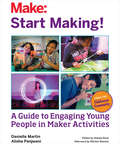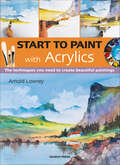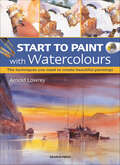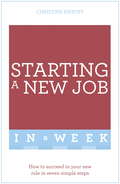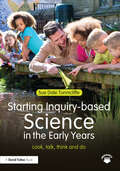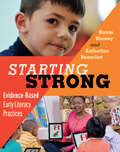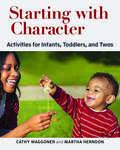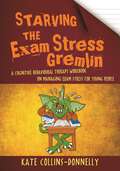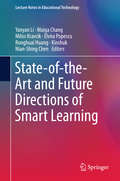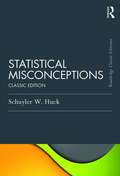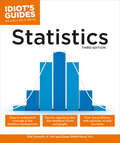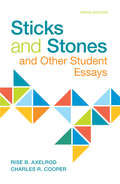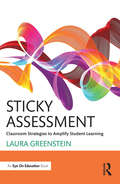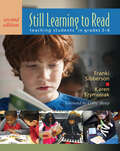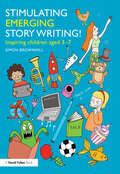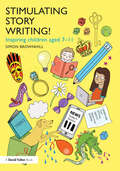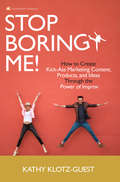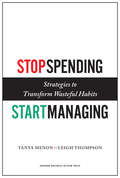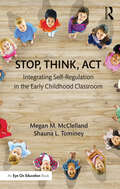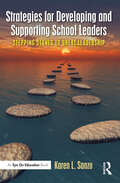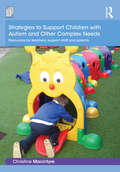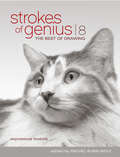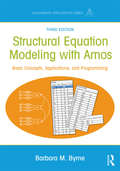- Table View
- List View
Start Making!: A Guide to Engaging Young People in Maker Activities
by Danielle Martin Alisha Panjwani Natalie RuskStart Making! is a program developed by the Clubhouse Network to engage young people all over the world in Maker-inspired activities. With this guide, you will discover how to plan and coordinate Start Making! projects in your home, school, library, community center, after-school club, or makerspace. You'll learn strategies for engaging young people in creative thinking, developing individual and team projects, and sharing and reflecting on their creations.Each session includes a list of the supplies you'll need, step-by-step instructions for completing the projects, and prompts for stimulating discussion, curiosity, and confidence. These fun do-it-yourself (and do-it-together) projects teach fundamental STEAM concepts -- science, technology, engineering, art, and math -- while introducing young people to the basics of circuitry, design, coding, crafting, and construction. They'll make paper cards and creations that light up, play music using a MaKey MaKey keyboard and Scratch programming, join together to make paintings with light, design and construct 3D sculptures, build a vibrating art-bot that makes drawings, and sew fabric creations with wearable circuits.Dip into the activities once a week, run them as a week-long summer activity, or go through the guide in any way that works for you. By offering your own Start Making! program, you can inspire young people in your community to develop creative ideas, learn new skills, and share their creations.The Clubhouse Network is a global network of community-based centers led by Boston's Museum of Science in collaboration with the MIT Media Lab.
Start to Paint with Acrylics: The Techniques You Need to Create Beautiful Paintings
by Arnold LowreyArnold Lowrey is a popular and experienced author and artist, well-known on both sides of the Atlantic. In this new edition of his popular book Painting with Acrylics (Search Press, 2006) he offers an inspiring and creative introduction to painting with acrylics, and in clear, simple-to-understand terms he explores the materials and techniques you will need to get started in this exciting medium. Using a vibrant and colourful palette, he clearly illustrates all the materials, tools and basic techniques followed by a series of step-by-step demonstrations to build up skills. Before you realise it you will be producing your own beautiful paintings - with this fresh, innovative introduction to acrylics.
Start to Paint with Watercolours: The Techniques You Need to Create Beautiful Paintings
by Arnold LowreyArnold Lowrey is a popular and experienced author and artist, well-known on both sides of the Atlantic. In this new edition of his popular book Starting to Paint (Search Press, 2003) he offers an inspiring and creative introduction to watercolours, and in clear, simple-to-understand terms he explores the materials and techniques you will need to start painting. Using a vibrant and colourful palette, he clearly illustrates all the techniques from laying initial washes and capturing atmosphere to adding interest and detail – and includes a series of step-by-step demonstrations to build up skills. Before you realise it you will be painting your own beautiful paintings – with this fresh, innovative introduction to watercolours.
Starting A New Job In A Week: How To Succeed In Your New Role In Seven Simple Steps
by Christine HarveySucceeding in your new job just got easierWhy is it that we don't learn at school some of the most important things we'll need for life? These are things like how to succeed in relationships, how to read a contract for buying a home - and how to start a new job successfully. These are things we eventually glean from other people, through observation or through trial and error. The purpose of this book is to cut out the trial and error and to give you the experiences of highly successful people so that you can succeed now.This book covers the essential ingredients you'll need for succeeding in your new job. They include:- Preparing before you start- Handling day one with ease- Having great success with your boss and colleagues- Using the right attitudes (ones that get you promoted not demoted)- Planning your leadership future by halting failure- Promoting loyalty and leading change- Succeeding as a leader (handling difficult situations head on)- Reaching your goals with proper monitors and controlsKeep pen and paper to hand as you read each day's chapter so that you can make notes when prompted. Your notes will build up into a useful set of prompts for you as youmake your mark in the new job.
Starting Inquiry-based Science in the Early Years: Look, talk, think and do
by Sue Dale TunnicliffeYoung children are intuitive scientists. This book builds on their inherent curiosity and problem solving as they move forward in their scientific thinking. Science develops from early beginnings and a solid foundation in the early years is essential for their future learning and engagement with the subject. Starting Inquiry Based Science in the Early Years shows you how you can support children’s emerging scientific skills by working with them and scaffolding their inquiries as they experiment, hypothesise and investigate building on their natural curiosity. Full of practical advice, it offers a wide range of scientific activities that can be carried out in partnership with young children. Each activity presents a challenge for the child to solve by thinking and talking through their ideas and then carrying out their own investigations. This invaluable guide focuses on helping children to follow their own line of inquiry and supporting them in mastering the skills and vocabulary they need in order to do this. Features include: An explanation of the key skills children need to acquire and practical ideas for developing these; Useful lists of relevant vocabulary and everyday resources; Cue questions to encourage children’s thinking skills; Cross-curricular links to show how the activities support early literacy and mathematics. Providing a rich bank of resources for promoting scientific experiences and learning, this highly practical book will help you ensure that the children in your care have the strong foundations they need to become confident, successful scientists in the future.
Starting Strong: Evidence-Based Early Literacy Practices
by Katrin Blamey Katherine A. BeauchatStarting Strong: Evidence-Based Early Literacy Practices shows teachers how to use four proven instructional approaches-;standards based, evidenced based, assessment based, and student based-;to improve their teaching practice in all areas of early literacy.Authors Katrin Blamey and Katherine Beauchat draw on their years of experience and early literacy expertise to guide you in figuring out what to teach and how to find the most instructionally sound method to teach it. They help you determine the instructional needs of your classroom and take full advantage of what you know about your students so you can engage them in learning.With chapters on oral language, vocabulary, phonological awareness, word recognition, comprehension, and writing skills, this comprehensive book explains each skill and provides research-based strategies for targeting each area. Supported by evidence-based research and aligned to key tenets of the Common Core, the book also includes classroom-tested activities and children's literature suggestions for each area of literacy.Starting Strong is an essential resource that any early literacy teacher or coach using a balanced literacy approach can use to build a solid foundation for their students.
Starting Your Career as an Illustrator: Revised Edition (Starting Your Career Ser.)
by Michael FleishmanFrom the first steps of starting out up through succeeding as a professional, Fleishman's newest guide navigates how illustration ties concept and technique. From advice on education and finding the right state of mind, through opening shop and finding the right venue, Starting Your Career as an Illustrator is a bit of a technical how-to, something of a business book, certainly an inspirational work, definitely a professional overview, even a personal lifestyle guide. It accurately documents the eclectic adventures of illustrators now, as well as relating historical perspectives, motivations, and inspirations to balance that picture and present readers with a true global field experience-all in an accessible, reader-friendly style. Topics include how to:Create a portfolioMake initial contactsDevelop a financial planSet up an officeAcquire supplies and equipmentPrice your own workMarket on the WebNurture a growing freelance businessAnd much moreThrough direct and candid conversations with scores of professionals up and down the career ladder, this book offers rich perspectives of illustrators (and their cohorts) at and away from the drawing board. It looks at the strong threads tying professional and academic process, practice, and product, and offers extensive research, a global pool of resources, and a wide panorama of info that promotes problem solving by way of a spectrum of ideas. Over fifty illustrations are included throughout.Allworth Press, an imprint of Skyhorse Publishing, publishes a broad range of books on the visual and performing arts, with emphasis on the business of art. Our titles cover subjects such as graphic design, theater, branding, fine art, photography, interior design, writing, acting, film, how to start careers, business and legal forms, business practices, and more. While we don't aspire to publish a New York Times bestseller or a national bestseller, we are deeply committed to quality books that help creative professionals succeed and thrive. We often publish in areas overlooked by other publishers and welcome the author whose expertise can help our audience of readers.
Starting with Character
by Cathy Waggoner Martha HerndonStarting with Character focuses on character development in infants, toddlers, and twos. This guide provides everything needed for preparing the environment, creating routines, and evaluating individual learning styles. Lesson plans and steps for creating new lessons are provided, as well as guides for evaluating children's progress. Facilitate the development of key character traits in children: caring, honesty, integrity, respect, responsibility, and self-discipline.Cathy Waggoner has worked in the field of education since 1989 with experience as a child care director and administrator at the Promethean Foundation. Martha Herndon, PhD, has worked as both an ECE educator and researcher since 1975.
Starving the Exam Stress Gremlin: A Cognitive Behavioural Therapy Workbook on Managing Exam Stress for Young People
by Kate Collins-DonnellyStressed out by exams? Then the exam stress gremlin is in town! Exam fears and worries are his favourite foods, and the more of these you feed him, the bigger he gets and the more stressed you become. But he can be stopped! Starve him of stress-related thoughts, feelings and behaviours and feel him and your stress fade away! Part of the award-winning Starve the Gremlin series and full of engaging activities, this self-help workbook explains what exam stress is, how it develops and the impact it can have - providing the reader with an understanding of their own exam stress. Rooted in cognitive behavioural therapy, it is also bursting with strategies to help the reader manage their exam stress by changing how they think and act. Starving the Exam Stress Gremlin can be completed independently by young people aged 10+ or with supervision, and with exam stress on the rise among our young people, this invaluable resource will also be of interest to school counsellors, teaching staff, youth workers and social workers and parents.
State-of-the-Art and Future Directions of Smart Learning
by Kinshuk Yanyan Li Ronghuai Huang Maiga Chang Nian-Shing Chen Milos Kravcik Elvira PopescuThis book provides an archival forum for researchers, academics, practitioners and industry professionals interested and/or engaged in reforming teaching and learning methods by transforming today's learning environments into smart learning environments. It will facilitate opportunities for discussions and constructive dialogue between various stakeholders on the limitations of current learning environments, the need for reform, innovative uses of emerging pedagogical approaches and technologies, and sharing and promoting best practices, which will lead to the evolution, design and implementation of smart learning environments. The focus of the contributions is on the interplay and fusion of pedagogy and technology to create these new environments. The components of this interplay include but are not limited to: Pedagogy: learning paradigms, assessment paradigms, social factors, policy Technology: emerging technologies, innovative uses of mature technologies, adoption, usability, standards, and emerging/new technological paradigms (open educational resources, cloud computing, etc. ) Fusion of pedagogy and technology: transformation of curricula, transformation of teaching behavior, transformation of administration, best practices of infusion, piloting of new ideas.
Statistical Misconceptions: Classic Edition (Psychology Press & Routledge Classic Editions)
by Schuyler W. HuckThis engaging book helps readers identify and then discard 52 misconceptions about data and statistical summaries. The focus is on major concepts contained in typical undergraduate and graduate courses in statistics, research methods, or quantitative analysis. Interactive Internet exercises that further promote undoing the misconceptions are found on the book's website. The author’s accessible discussion of each misconception has five parts: The Misconception - a brief description of the misunderstanding Evidence that the Misconception Exists – examples and claimed prevalence Why the Misconception is Dangerous – consequence of having the misunderstanding Undoing the Misconception - how to think correctly about the concept Internet Assignment - an interactive activity to help readers gain a firm grasp of the statistical concept and overcome the misconception. The book's statistical misconceptions are grouped into 12 chapters that match the topics typically taught in introductory/intermediate courses. However, each of the 52 discussions is self-contained, thus allowing the misconceptions to be covered in any order without confusing the reader. Organized and presented in this manner, the book is an ideal supplement for any standard textbook. An ideal supplement for undergraduate and graduate courses in statistics, research methods, or quantitative analysis taught in psychology, education, business, nursing, medicine, and the social sciences. The book also appeals to independent researchers interested in undoing their statistical misconceptions.
Statistics, 3E (Idiot's Guides)
by Robert A. Donnelly Fatma Abdel-RaoufStatistics is a class that is required in many college majors, and it&’s an increasingly popular Advanced Placement (AP) high school course. In addition to math and technical students, many business and liberal arts students are required to take it as a fundamental component of their majors. A knowledge of statistical interpretation is vital for many careers. Idiot&’s Guides®: Statistics explains the fundamental tenets in language anyone can understand. Content includes: - Calculating descriptive statistics. - Measures of central tendency: mean, median, and mode. - Probability. - Variance analysis. - Inferential statistics. - Hypothesis testing. - Organizing data into statistical charts and tables.
Sticks and Stones: And Other Student Essays
by Rise B. Axelrod Charles R. CooperThis unique collection of essays written by students around the country offers diverse and accessible models for the writing assignments in Part 1 of The St. Martin's Guide to Writing. The chapters in Sticks and Stones correspond to the chapters in Part One of the Guide. Packaged free with the Guide
Sticky Assessment: Classroom Strategies to Amplify Student Learning
by Laura GreensteinSticky Assessment is a straightforward guide to assessment, designed to demystify assessment and to give teachers the tools they need become better assessors. Translating the latest research into a concise and practical volume, this book helps teachers to monitor student learning, make assessment engaging and meaningful for students, and to use assessment that improves rather than merely measures learning outcomes. With examples from classroom teachers and exercises designed to help teachers think through their processes, this book will be an invaluable and lasting resource for classroom teachers.
Still Learning to Read: Teaching Students in Grades 3–6
by Franki Sibberson Karen SzymusiakAuthors Franki Sibberson and Karen Szymusiak are back with an updated version of Still Learning to Read: Teaching Students in Grades 3-6, 2nd Edition. In the years since the first edition, prevalence of testing and Common Core State Standards have redefined requirements and what is expected of both teachers and students.This new edition focuses on the needs of students in grades 3-6 in for the following areas: reading workshops, read-alouds, classroom design, digital tools, fiction and nonfiction, and close reading. The authors examine current trends in literacy and introduce a new section on intentional instructional planning, as well as a new chapter on scaffolding for reading nonfiction. Expanded examples of lessons and routines to promote deeper thinking about learning are also included.In Still Learning to Read, you'll also find online videos that provide insight into classrooms. Students make book choices, work in small groups, and discuss their reading notebooks. Finally, updated and expanded book lists, recommendations for digital tools, lesson cycles, and sections for school leaders round out this foundational resource.
Stimulating Emerging Story Writing!: Inspiring children aged 3–7
by Simon BrownhillStimulating Emerging Story Writing! Inspiring Children aged 3-7 offers innovative and exciting ways to inspire young children to want to create stories and develop their emerging story writing skills. This practical guide offers comprehensive and informed support for professionals to effectively engage ‘child authors’ in stimulating story writing activities. Packed full of story ideas, resource suggestions and practical activities, the book explores the various ways professionals can help young children to develop the six key elements of story, these being character, setting, plot, conflict, resolution and ending. All of the ideas in the book are designed to support a setting’s daily writing provision such as mark making opportunities, role play and using simple open ended play resources. Separated into two sections and with reference to the EYFS and Key Stage 1 curricula, this timely new text provides practitioners with tried and tested strategies and ideas that can be used with immediate effect. Chapters include: Creating Characters The Plot Thickens Inspired Ideas Resourcing the Story Stimulation This timely new text is the perfect guide for inspiring young children aged 3-7 in the classroom and will be an essential resource for practitioners, teachers and students on both early years and teacher training courses.
Stimulating Story Writing!: Inspiring children aged 7-11
by Simon BrownhillStimulating Story Writing! Inspiring Children aged 7-11 offers innovative and exciting ways to inspire children to want to create stories and develop their story writing skills. This practical guide offers comprehensive and informed support for professionals to effectively engage ‘child authors’ in stimulating story writing activity. Packed full of story ideas, resource suggestions and practical activities, the book explores various ways professionals can help children to develop the six key elements of story, these being character, setting, plot, conflict, resolution and ending. All of the ideas in the book are designed to complement and enrich existing writing provision in classrooms with strategies such as role play, the use of different technologies, and using simple open ended resources as story stimuli. Separated into two sections and with reference to the Key Stage 2 curricula, this timely new text provides professionals with tried and tested strategies and ideas that can be used with immediate effect. Chapters include: • Creating Characters • The Plot Thickens • Inspired Ideas • Resourcing the Story Stimulation This timely new text is the perfect guide for inspiring children aged 7-11 in the classroom and will be an essential resource for teachers and students on teacher training courses.
Stop Boring Me!: How to Create Kick-Ass Marketing Content, Products and Ideas Through the Power of Improv
by Kathy Klotz-GuestComing up constantly with a steady stream of marketing content, stories, and ideas that inspire excitement, interest and banish boring can be challenging. Your content-weary audience is saying "Stop Boring Me!" You cannot connect meaningfully with your audience if you bore them. There's just too much content chasing too little mindshare today. And most business marketing stinks because it is transactional, superficial and not human. The good news: it doesn't have to be that way because everyone is creative. Your inner kid is smart because it knows how to play. What if you could create engaging marketing content and storytelling, and generate kick-ass, fun and relevant ideas for stories, articles, branding, social media campaigns, sales presentations, and even new products? Well there is a fun way to do exactly that: by applying key concepts from the world of improvisation. Don't worry - this is not about theatricality, so you don't have to perform. It is about playfulness, however, and unleashing your inner kid. Bringing key concepts from the improvisation stage to your marketing, sales, branding and products page - or business stage, if you like - can help you, your team, your company and your business generate ideas that kick boring to the curb. While this book will help you be more funny, it's focused on fun as a creative catalyst for content idea orgasms: when different things come together in a fresh, human and engaging way that makes you and your audience say "aww yeah!" The first half of the book centers on how to use key improv concepts to craft and tell better stories for sales, social media, articles, presentations, content, and other story-related contexts. The second half of the book is all about innovating massively creative marketing ideas for products, content, campaigns, customer service, sales processes, you name it. While this book was written primarily for marketing people who have to create content, tell stories, make presentations; anyone in the idea-generation business (and who isn't) can use the tips in this book. Whether you are in marketing, sales, HR, product or customer service, these exercises will help you innovate and unleash more creative awesome into your work. Here is to more idea orgasms for you and your audience.
Stop Spending, Start Managing: Strategies to Transform Wasteful Habits
by Leigh Thompson Tanya MenonToo often, managers spend money to solve problems at work, whether that means hiring outside consultants, investing in new software to fix communication issues, or bribing employees with cash to motivate them. But many managers are surprised when the problem they tried to solve reappears a few months, weeks, or even days later. The money is gone, but the problem is still there. These costs can add up, particularly when you consider the additional loss to your company in wasted time, energy, and resources when you don’t solve problems effectively. Tanya Menon and Leigh Thompson, experts in how organizations work, have developed a framework to help you understand why you fall into this trap, and how to escape it. Five psychologies—each of which substitutes spending for your own powers of management—lead to wasteful spending: 1. Mindless spending: throwing money at a problem to avoid thinking about it; 2. Ego spending: squandering resources to make yourself look good; 3. Please-like-me spending: wasting time and money to avoid conflict; 4. Talk-to-me spending: buying expensive technologies to help people communicate; and 5. Follow-me spending: using financial incentives to motivate people To break these habits, Menon and Thompson show how you can use your smarts as a manager to find solutions. By consciously observing waste and identifying hidden value, widening your mind-set beyond ego, courageously negotiating with others, encouraging meaningful interaction, and transforming people with positive values and relationships rather than cash, you can overcome these psychological barriers and find the value that already exists in your
Stop, Think, Act: Integrating Self-Regulation in the Early Childhood Classroom
by Megan M. McClelland Shauna L. TomineyStop, Think, Act: Integrating Self-regulation in the Early Childhood Classroom offers early childhood teachers the latest research and a wide variety of hands-on activities to help children learn and practice self-regulation techniques. Self-regulation in early childhood leads to strong academic performance, helps students form healthy friendships, and gives them the social and emotional resources they need to face high-stress situations throughout life. The book takes you through everything you need to know about using self-regulation principles during circle time, in literacy and math instruction, and during gross motor and outdoor play. Each chapter includes a solid research base as well as practical, developmentally-appropriate games, songs, and strategies that you can easily incorporate in your own classroom. With Stop, Think, Act, you’ll be prepared to integrate self-regulation into every aspect of the school day.
Strategies for Developing and Supporting School Leaders: Stepping Stones to Great Leadership
by Karen L. SanzoStrategies for Developing and Supporting School Leaders assists personnel in school districts to deliver appropriate development and support practices for aspiring and current school leaders. This book explores a variety of research-based and best-practice processes that can be implemented in school districts to prepare leaders to meet the technical and adaptive demands of school leadership and the needs of a diverse student population. Sanzo lays out a cohesive framework of key processes and activities that range from the very simple and immediately implementable, to the more complex and nuanced. Providing both the "how," and "why," this important resource shares ideas, strategies, tools, and systems to develop effective and meaningful professional learning opportunities to help promote highly effective schools and districts.
Strategies to Support Children with Autism and Other Complex Needs: Resources for teachers, support staff and parents
by Christine MacintyreWorking with young children on the autistic spectrum and supporting them as they learn can be fascinating, challenging, often overwhelmingly difficult, but more than anything else, hugely rewarding. Strategies to Support Children with Autism and other Complex Needs bridges the gap between explaining what autism is and finding ways to interact through having a balance of play activities interspersed with more formal teaching of skills of everyday living. This highly practical text provides a bank of strategies that are specially designed to be matched to the developmental status of each child. These strategies are endorsed by academics who have monitored the children’s responses in communicating, pretending, playing, moving, and singing and describe how the children have responded positively over time. This book covers a variety of topics such as: The importance of play for enhancing learning for children with autism and other complex needs Evaluating different ways of developing communication Transferring learning from one environment to another to aid memorizing. Understanding the impact of sensory hypo and hyperactivity on children’s learning. Developing a ‘Theory of Mind’ The importance of movement, music and having fun Observation and assessment schedules are provided, along with clear and helpful evaluation forms which show staff in primary and early years settings how children on the autistic spectrum can be helped to make meaningful and encouraging progress. This text is an vital read for any practitioners working with children on the autistic spectrum or with complex learning difficulties.
StriveTogether: Reinventing the Local Education Ecosystem
by Allen S. Grossman Ann Lombard Noah Fishercase
Strokes Of Genius 8: Expressive Texture (Strokes of Genius: The Best of Drawing #8)
by Rachel Rubin WolfInspiration fresh from the studios of 131 master artists! A celebration of creative drawing, the Strokes of Genius series showcases standout work from today's top artists. This 8th volume focuses on how artists use texture to bring life and depth to subjects ranging from soulful portraits and expressive still lifes, to beautiful landscapes and pulsing city scenes. Texture plays an essential role in each of these drawings--capturing character, building mood, and paying homage to everyday moments that often go unnoticed. These pages serve up a tantalizing buffet of tactile impressions, from rough tree bark and silky fur to peeling paint and timeworn fabrics. Complete with fascinating, firsthand insights on the drawing techniques behind the textures, Strokes of Genius 8 offers hours of browsing and inspiration for artists and art-lovers alike. Inside you'll find:139 magnificent works in charcoal, pencil, pastel, colored pencil, scratchboard and pen+inkAn exciting range of styles and approaches, presented in subject-themed chaptersA behind-the-scenes look at the tools and methods used to evoke a wide range of natural and manmade textures
Structural Equation Modeling With AMOS: Basic Concepts, Applications, and Programming, Third Edition (Multivariate Applications Series)
by Barbara M. ByrneThis bestselling text provides a practical guide to structural equation modeling (SEM) using the Amos Graphical approach. Using clear, everyday language, the text is ideal for those with little to no exposure to either SEM or Amos. The author reviews SEM applications based on actual data taken from her own research. Each chapter "walks" readers through the steps involved (specification, estimation, evaluation, and post hoc modification) in testing a variety of SEM models. Accompanying each application is: an explanation of the issues addressed and a schematic presentation of hypothesized model structure; Amos? input and output with interpretations; use of the Amos toolbar icons and pull-down menus; and data upon which the model application was based, together with updated references pertinent to the SEM model? tested. Thoroughly updated throughout, the new edition features: All new screen shots featuring Amos Version 23.?? Descriptions and illustrations of Amos’ new Tables View format which enables the specification of a structural model in spreadsheet form.???? Key concepts and/or techniques that introduce each chapter. Alternative approaches to model analyses when enabled by Amos thereby allowing users to determine the method best suited to their data.? Provides analysis of the same model based on continuous and categorical data (Ch. 5) thereby enabling readers to observe two ways of specifying and testing the same model as well as compare results. All applications based on the Amos graphical mode interface accompanied by more "how to" coverage of graphical techniques unique to Amos. More explanation of key procedures and analyses that address questions posed by readers All application data files are available at www.routledge.com/9781138797031. The two introductory chapters in Section 1 review the fundamental concepts of SEM methodology and a general overview of the Amos program. Section 2 provides single-group analyses applications including two first-order confirmatory factor analytic (CFA) models, one second-order CFA model, and one full latent variable model. Section 3 presents multiple-group analyses applications with two rooted in the analysis of covariance structures and one in the analysis of mean and covariance structures. Two models that are increasingly popular with SEM practitioners, construct validity and testing change over time using the latent growth curve, are presented in Section 4. The book concludes with a review of the use of bootstrapping to address non-normal data and a review of missing (or incomplete) data in Section 5. An ideal supplement for graduate level courses in psychology, education, business, and social and health sciences that cover the fundamentals of SEM with a focus on Amos, this practical text continues to be a favorite of both researchers and practitioners. A prerequisite of basic statistics through regression analysis is recommended but no exposure to either SEM or Amos is required.
